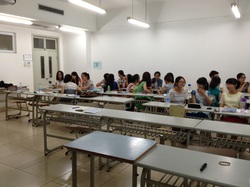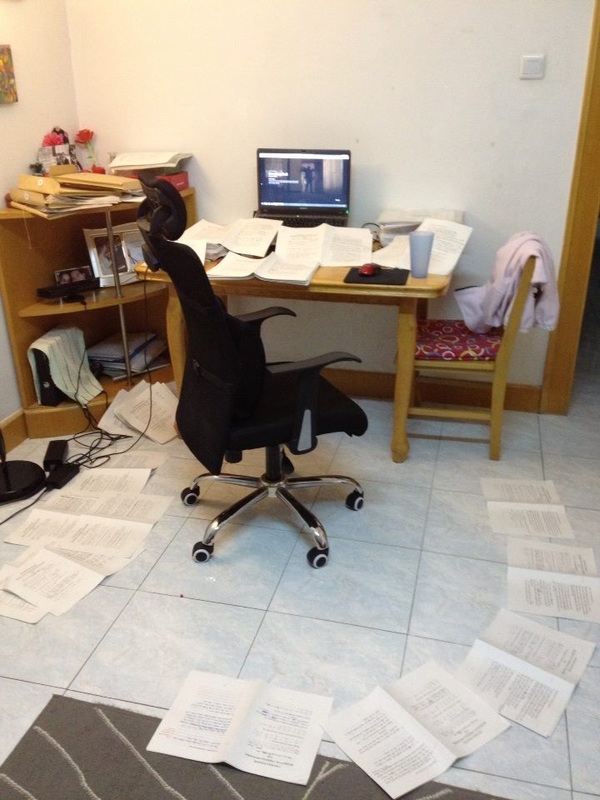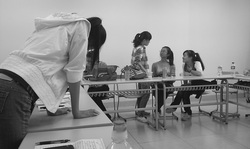Now, I am back in a Chinese university teaching English. I have many more students but a lot more time outside of the classroom, so hopefully, I will be able to get back into a more regular blogging schedule.
For my first post, I want to tell you about a great first-day "getting to know you" activity that I've been doing with students for the past several years. This is an activity I first started using with undergraduate English majors at a university in Tianjin.
I have also adapted it for smaller groups of middle school students in ESL classrooms, and recently, I just used it again for the first day of my new classes this semester at my new university job in Qingdao, teaching English to postgraduate non-English major students.
I took a few photos and a video of the activity this time because I was so impressed by the literal 100% engagement rate of this activity. In the past, it's been successful as well, but my students this semester particularly seemed to enjoy it. As non-English majors, they have a slightly lower oral English level than students I've used this activity with in the past, so I expected it to be a somewhat challenging activity for them, but they persevered and used pretty much only English the entire time they worked on this activity. They also had so much enthusiasm while doing it!
1) Create a "Bingo" style chart on one side of the paper with boxes that have interesting things that would help students get to know one another.
For example, "I have been to Thailand," "I have a brother or sister," and "I know how to count to 3 in Korean." You can contextualize the boxes based on the student population. For my Chinese students, it's likely that some but not all will have been to Thailand or can count in Korean since we are in Asia. It's also likely that some but not all will have a brother or sister due to the one-child policy only recently relaxing. The point is to pick things that probably will be true for a few students but not obviously true for most or all students.
2) In class, students walk around the room with their Bingo sheet and ask each other questions (in English only) to find out if the person they are talking to matches any of their boxes.
If a student says "Yes" to one of the questions, the person should ask for his or her name and if necessary, how to spell it. They should not simply give their paper to other students and ask them to sign it. This will not help students communicate and will not help them learn one another's names!
Students try to cheat on this all the time, so you need to remind them throughout the activity and model it for them before they begin the activity to make sure they know that they need to ask for the other person's name and write it themselves instead of just throwing their paper in front of people to quickly fill it up.
This part of the activity is quite flexible. As time allows, you can have your students do this like Bingo - whoever completes a row vertically, horizontally, or diagonally is the winner. Or, you can have students try to fill the whole paper and give the fastest person a prize. I have done prizes in the past, but this semester, I didn't have any prizes or competition element at all. I just told the students to try their best to fill up the whole page. We had a lot of time available for this activity, so I wasn't worried about speed and just wanted them to enjoy the process. They definitely had a good time with it even without any competition or scoring involved.
You can see the instructions I give to students in my example handout below. (This is actually the handout I used with my international school ESL students, so the first page boxes reflect that population. I kept the second page the same for my university classes and middle school classes. It works regardless of the student population and doesn't really need any changes since it is so general.)
Give students some time to think of and write down 3 questions to ask their partner about the topic so that they can learn more about it. (For example: When did you learn to count in Korean? What else can you say in Korean? Do you know how to count in any other languages?)
If you have a low-language level population of students, and if you have enough time, you can do a quick lesson about how to form questions correctly in English. Model several examples so students can have help writing their questions. Depending on the level of your students, the size of your class, and the time you have, this part can be very guided by the teacher or independent work time.
After students have their questions ready, give them time to interview one another. They should take notes about their partner's answers because after this activity is over, some (or all) students will share the information about their partner with the whole class.
During this time, I had a model paragraph of how to introduce a partner on the PowerPoint at the front of the room so that students could imitate my example. i.e. "This is my partner, Peter. He knows how to count to 3 in Korean. He learned it when he was a baby because he is from South Korea. He can say almost anything in Korean because it's his first language. He can also count in English, Chinese, and Spanish."
Depending on the language level of your students, you may need to give some explicit instruction about how to transfer the partner's answers into third-person statements. (I had to do this with my postgraduate students this semester.)
5) Now, it's time to have some or all students stand in front of the class and introduce their partner to the class.
I had enough time this semester to have each student share, but if your time doesn't allow, you can have a few students share or none at all and just read their paragraphs later.
I have never formally assessed their paragraph writing for this activity, but if you wanted to give a score for it, you could. You can also use it to get a baseline for the students' grammar, spelling, etc.
If you have a smaller group and/or a lot of time, and if you think your students have a high enough language level, you can ask the listening audience members to think of another question they can ask after each person is introduced. (So for the example above of Peter, an audience member could raise her hand and ask, "When did you learn how to count in Spanish?" and Peter would have to answer her out loud on the spot.)
I love using this "get to know you" activity because it's flexible and easy to plan. It can take as much or as little time as you want. It helps students practice all domains of language - speaking, listening, reading, and writing. It quickly helps you to see how confident and comfortable students are using English and to get a feel for some of their common mistakes. Most importantly, students seem to love it, too!
I've only used this activity in ELL (English language learning) classrooms, but of course, it can be used in any class, even with native English speakers since, again, it's a very flexible activity. If you wanted to use it for a math or science class or any content area class, you can just replace some of the Bingo boxes with content-area questions. (Examples: I know what a variable is; I know how to solve this equation...)
I hope it helps you try a fun new first-day activity with your students!






 RSS Feed
RSS Feed
